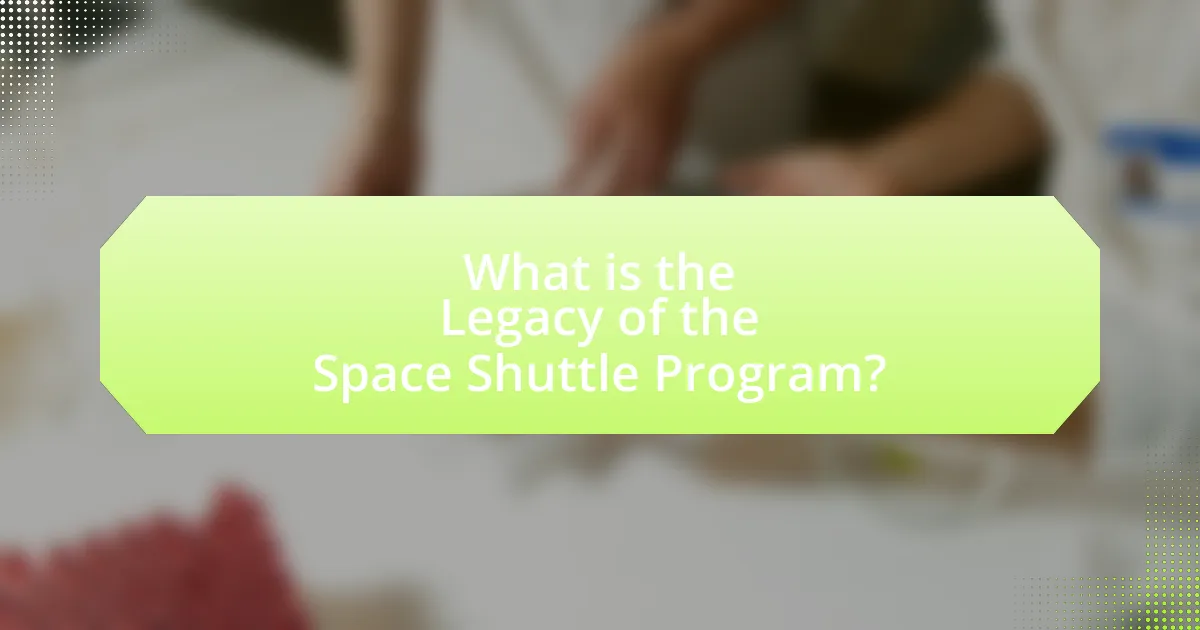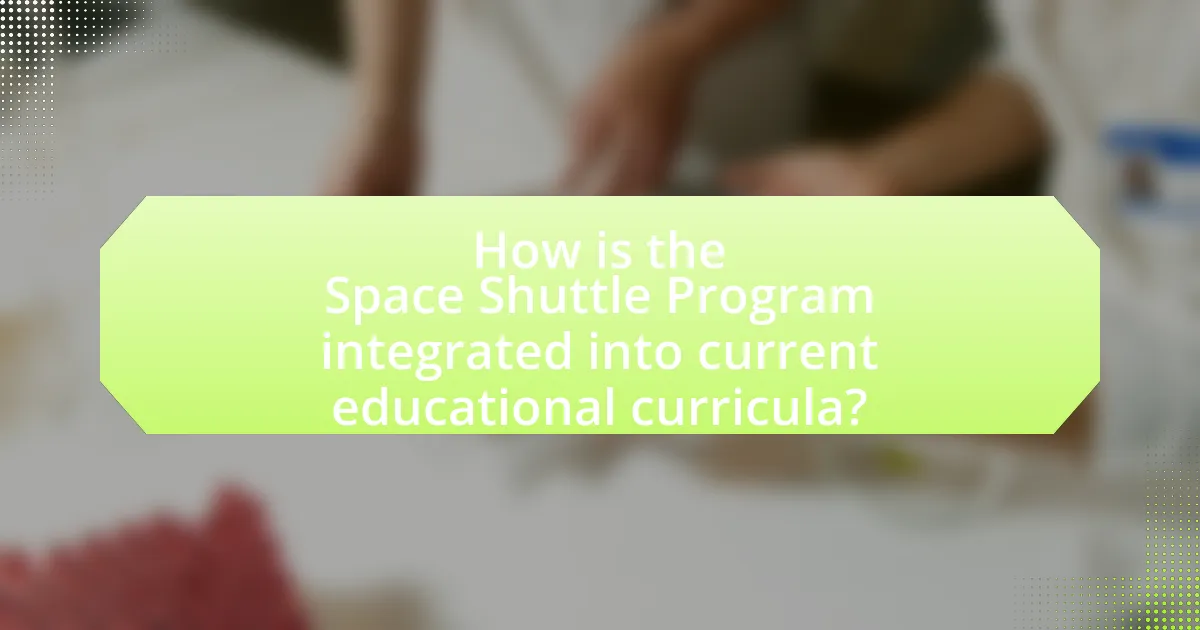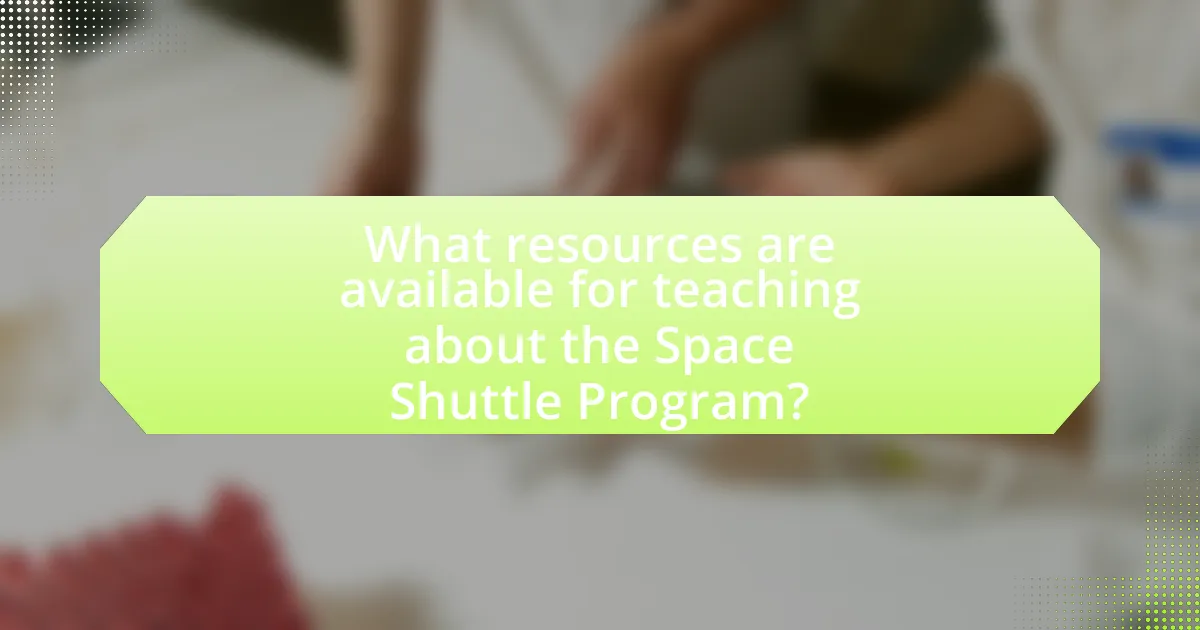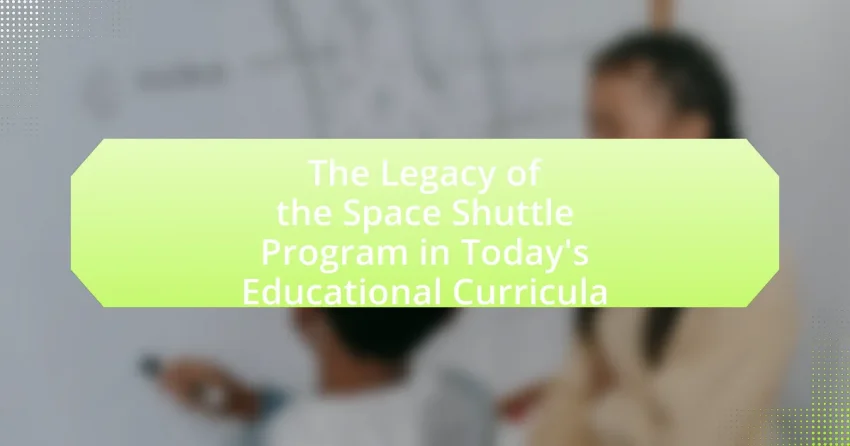The main entity of the article is the Space Shuttle Program and its legacy in contemporary educational curricula. The article outlines the program’s significant contributions to human spaceflight, scientific research, and international collaboration from 1981 to 2011, highlighting its impact on STEM education. It discusses how educators incorporate the program’s milestones and technological advancements into lessons, fostering critical thinking and problem-solving skills among students. Additionally, the article examines the resources available for teaching about the Space Shuttle, the role of hands-on activities, and the importance of collaborative projects in engaging students with its legacy.

What is the Legacy of the Space Shuttle Program?
The legacy of the Space Shuttle Program is its significant contribution to human spaceflight, scientific research, and international collaboration in space exploration. The program, which operated from 1981 to 2011, completed 135 missions, enabling the construction of the International Space Station (ISS) and facilitating numerous scientific experiments in microgravity. This legacy is evident in educational curricula, where the program serves as a case study for engineering, physics, and teamwork, illustrating the complexities and achievements of space missions. The program’s advancements in reusable spacecraft technology have also influenced modern aerospace engineering, shaping future missions and inspiring new generations of scientists and engineers.
How did the Space Shuttle Program influence educational practices?
The Space Shuttle Program significantly influenced educational practices by integrating real-world applications of science, technology, engineering, and mathematics (STEM) into curricula. The program’s missions provided a platform for hands-on learning experiences, such as the development of educational materials that utilized data and experiments conducted in space. For instance, the NASA Educational Outreach Program created resources that aligned with national science standards, allowing students to engage with concepts like microgravity and orbital mechanics. Additionally, the program inspired initiatives like the “Shuttle Education Program,” which aimed to enhance student interest in STEM fields through interactive projects and partnerships with schools. These efforts have led to increased enrollment in STEM courses and a greater emphasis on experiential learning in educational settings.
What key milestones in the Space Shuttle Program are taught in schools?
Key milestones in the Space Shuttle Program taught in schools include the first shuttle launch, STS-1, on April 12, 1981, which marked the beginning of reusable spacecraft. Another significant milestone is the deployment of the Hubble Space Telescope during STS-31 on April 24, 1990, which revolutionized astronomy. The tragic loss of the Challenger on January 28, 1986, during STS-51-L is also a critical teaching point, emphasizing the importance of safety in space exploration. Additionally, the final shuttle mission, STS-135, on July 8, 2011, represents the conclusion of the program and its contributions to the International Space Station. These milestones are integral to understanding the program’s impact on space exploration and technology.
How do educators incorporate the history of the Space Shuttle into their curricula?
Educators incorporate the history of the Space Shuttle into their curricula by integrating lessons on its technological advancements, missions, and impact on space exploration. For example, they utilize the Space Shuttle’s role in deploying satellites, conducting scientific research, and assembling the International Space Station to illustrate real-world applications of physics and engineering concepts. Additionally, educators often include discussions on significant events, such as the Challenger and Columbia disasters, to teach about safety, ethics, and the importance of risk management in engineering. This approach not only enhances students’ understanding of space science but also fosters critical thinking and problem-solving skills by analyzing historical data and outcomes related to the Space Shuttle program.
Why is the Space Shuttle Program significant in today’s education?
The Space Shuttle Program is significant in today’s education because it serves as a pivotal example of engineering innovation and scientific exploration. The program, which operated from 1981 to 2011, facilitated the deployment of satellites, the construction of the International Space Station, and numerous scientific experiments in microgravity. These achievements provide real-world case studies for students in STEM (Science, Technology, Engineering, and Mathematics) fields, illustrating the application of theoretical concepts in practical scenarios. Furthermore, the program’s emphasis on teamwork, problem-solving, and resilience in the face of challenges offers valuable lessons in collaboration and critical thinking, essential skills for the modern workforce.
What lessons can be learned from the successes and failures of the program?
The lessons learned from the successes and failures of the Space Shuttle program include the importance of rigorous safety protocols and the need for continuous innovation in engineering practices. The program’s successes, such as the deployment of the Hubble Space Telescope, demonstrated the value of long-term investment in technology and collaboration among diverse teams. Conversely, the failures, particularly the Challenger and Columbia disasters, highlighted critical lapses in safety culture and communication, underscoring the necessity for transparent risk assessment and management. These experiences inform current educational curricula by emphasizing the integration of safety, teamwork, and problem-solving skills in STEM education.
How does the program inspire future generations in STEM fields?
The Space Shuttle program inspires future generations in STEM fields by providing a tangible example of innovation, teamwork, and problem-solving in real-world applications. The program’s achievements, such as launching satellites and constructing the International Space Station, serve as case studies in educational curricula, illustrating the importance of science, technology, engineering, and mathematics. Furthermore, initiatives like NASA’s educational outreach programs and partnerships with schools promote hands-on learning experiences, encouraging students to engage with STEM subjects. Research indicates that students exposed to such programs show increased interest in pursuing STEM careers, as evidenced by a 2019 study from the National Science Foundation, which found that students participating in STEM-focused activities were 50% more likely to consider a career in these fields.

How is the Space Shuttle Program integrated into current educational curricula?
The Space Shuttle Program is integrated into current educational curricula through STEM (Science, Technology, Engineering, and Mathematics) initiatives that utilize its historical missions and technological advancements as teaching tools. Educational programs often include lessons on the engineering challenges faced during the Shuttle missions, such as the development of reusable spacecraft and the complexities of human spaceflight. For instance, NASA’s educational resources provide teachers with lesson plans that incorporate real data and mission scenarios, allowing students to engage in problem-solving activities that reflect the challenges encountered by engineers and astronauts. This integration not only enhances students’ understanding of aerospace engineering but also inspires interest in careers related to space exploration, as evidenced by increased enrollment in STEM fields following the introduction of such curricula.
What subjects benefit from the inclusion of the Space Shuttle Program?
The subjects that benefit from the inclusion of the Space Shuttle Program are science, technology, engineering, and mathematics (STEM) education. The Space Shuttle Program, operational from 1981 to 2011, provided real-world applications of complex scientific principles, fostering interest and understanding in these fields. For instance, the program’s emphasis on physics, aerodynamics, and materials science illustrates key concepts in a practical context, enhancing student engagement and comprehension. Additionally, the program’s role in advancing engineering practices and technological innovations serves as a case study for students, demonstrating the importance of interdisciplinary approaches in solving real-world problems.
How is the Space Shuttle used to teach physics and engineering concepts?
The Space Shuttle is used to teach physics and engineering concepts through hands-on experiments, simulations, and real-world applications of scientific principles. Educational programs utilize the Shuttle’s design and operational history to illustrate concepts such as thrust, aerodynamics, and the physics of space travel. For instance, the Shuttle’s launch and re-entry phases serve as practical examples of Newton’s laws of motion, while its engineering challenges highlight the importance of materials science and structural integrity in aerospace design. Additionally, NASA’s educational resources, including the Space Shuttle’s mission data and engineering challenges, provide students with concrete examples of problem-solving and innovation in real-world scenarios.
What role does the Space Shuttle play in promoting critical thinking and problem-solving skills?
The Space Shuttle plays a significant role in promoting critical thinking and problem-solving skills by providing real-world applications of complex scientific and engineering principles. Through its missions, students and educators can analyze the challenges faced during space travel, such as life support systems, navigation, and re-entry, which require innovative solutions and collaborative teamwork. For instance, the Shuttle’s development involved extensive problem-solving to address issues like thermal protection and propulsion, demonstrating the importance of critical thinking in overcoming obstacles. Educational programs that incorporate the Space Shuttle’s legacy often engage students in hands-on projects that mimic these challenges, fostering an environment where critical thinking and problem-solving are essential for success.
How do educators assess the impact of the Space Shuttle Program on students?
Educators assess the impact of the Space Shuttle Program on students through various methods, including surveys, standardized tests, and project-based assessments. These assessments often measure students’ knowledge of space science, engineering principles, and their ability to apply critical thinking skills. For instance, studies have shown that students exposed to the Space Shuttle Program’s curriculum demonstrate improved engagement in STEM subjects, with a 2018 report from the National Science Foundation indicating a 15% increase in student interest in science and technology fields after participating in related educational programs. Additionally, educators analyze student projects that incorporate themes from the Space Shuttle missions, evaluating creativity and problem-solving abilities, which further illustrates the program’s influence on student learning outcomes.
What metrics are used to evaluate student engagement with space-related topics?
Metrics used to evaluate student engagement with space-related topics include participation rates in space-themed activities, assessment scores on related coursework, and qualitative feedback from surveys. Participation rates provide quantitative data on how many students are involved in programs or events focused on space, while assessment scores reflect students’ understanding and retention of space-related concepts. Qualitative feedback from surveys offers insights into students’ interests and attitudes towards space topics, allowing educators to gauge engagement levels more comprehensively. These metrics collectively help in understanding the effectiveness of educational initiatives related to space.
How do student projects related to the Space Shuttle reflect learning outcomes?
Student projects related to the Space Shuttle reflect learning outcomes by enhancing critical thinking, problem-solving skills, and interdisciplinary knowledge. These projects often require students to engage with complex scientific concepts, engineering principles, and historical context, thereby fostering a deeper understanding of aerospace technology and its implications. For instance, students may analyze the engineering challenges faced during the Space Shuttle missions, which promotes analytical skills and teamwork. Additionally, projects that involve designing models or simulations of the Space Shuttle encourage creativity and application of theoretical knowledge in practical scenarios, aligning with educational standards that emphasize hands-on learning and real-world applications.

What resources are available for teaching about the Space Shuttle Program?
Resources available for teaching about the Space Shuttle Program include NASA’s official website, which offers educational materials, lesson plans, and multimedia resources specifically designed for educators. Additionally, the Smithsonian National Air and Space Museum provides access to artifacts, exhibits, and online resources related to the Space Shuttle, enhancing the learning experience. Furthermore, various educational organizations, such as the Challenger Center for Space Science Education, offer programs and activities that focus on the Space Shuttle’s missions and impact on space exploration. These resources are validated by their association with reputable institutions and their commitment to promoting STEM education.
What types of educational materials are created around the Space Shuttle Program?
Various types of educational materials are created around the Space Shuttle Program, including textbooks, interactive simulations, documentaries, and lesson plans. Textbooks often cover the history, engineering, and scientific contributions of the Space Shuttle, providing students with a comprehensive understanding of its significance in space exploration. Interactive simulations allow learners to engage with the mechanics of shuttle launches and missions, enhancing their grasp of physics and engineering principles. Documentaries present visual narratives of the shuttle’s missions, showcasing real footage and interviews with astronauts, which enriches the educational experience. Lesson plans designed for educators incorporate these materials, aligning them with curriculum standards to facilitate effective teaching about space science and technology.
How can teachers access NASA’s educational resources related to the Space Shuttle?
Teachers can access NASA’s educational resources related to the Space Shuttle by visiting the NASA website, specifically the Education section, which offers a variety of materials including lesson plans, activities, and multimedia resources. NASA provides these resources to support educators in integrating space science into their curricula, reflecting the legacy of the Space Shuttle Program. The website features dedicated pages for the Space Shuttle, where teachers can find historical information, mission details, and educational tools designed to enhance student learning about space exploration.
What role do documentaries and films play in teaching about the Space Shuttle?
Documentaries and films serve as vital educational tools in teaching about the Space Shuttle by providing visual narratives that enhance understanding of its history, technology, and impact. These media formats engage audiences through storytelling, making complex scientific concepts more accessible. For instance, documentaries like “The Last Shuttle” and “Space Shuttle: The Final Mission” offer firsthand accounts from astronauts and engineers, illustrating the challenges and triumphs of the program. Additionally, films often include archival footage and animations that depict shuttle launches and missions, which help viewers visualize the engineering feats involved. This combination of personal stories and visual representation reinforces the significance of the Space Shuttle in space exploration and education, making it a compelling subject for learners of all ages.
What best practices can educators follow when teaching about the Space Shuttle Program?
Educators can enhance teaching about the Space Shuttle Program by incorporating hands-on activities, utilizing multimedia resources, and connecting the program to current scientific advancements. Hands-on activities, such as building model rockets, allow students to engage with the principles of rocketry and engineering, fostering a deeper understanding of the challenges faced by the Space Shuttle missions. Utilizing multimedia resources, including videos and interactive simulations, can vividly illustrate the complexities of space travel and the technology involved, making the learning experience more dynamic. Additionally, linking the Space Shuttle Program to contemporary topics, such as advancements in space exploration and technology, helps students appreciate its relevance and impact on current scientific endeavors. For instance, the Space Shuttle’s role in constructing the International Space Station highlights its lasting legacy in international collaboration in space science.
How can hands-on activities enhance learning about the Space Shuttle?
Hands-on activities enhance learning about the Space Shuttle by providing experiential learning opportunities that engage students in practical applications of theoretical concepts. These activities, such as building model rockets or simulating shuttle launches, allow learners to directly interact with the principles of physics, engineering, and space science. Research indicates that experiential learning can improve retention rates and understanding of complex subjects; for instance, a study published in the Journal of Educational Psychology found that students who participated in hands-on science activities scored significantly higher on assessments compared to those who learned through traditional methods. This approach not only fosters critical thinking and problem-solving skills but also ignites interest in STEM fields, aligning with the educational goals inspired by the legacy of the Space Shuttle program.
What collaborative projects can be developed to engage students with the Space Shuttle legacy?
Collaborative projects that can engage students with the Space Shuttle legacy include building scale models of the Space Shuttle, conducting experiments that simulate shuttle missions, and creating multimedia presentations on shuttle missions and their impact on space exploration. These projects allow students to apply STEM concepts in a hands-on manner, fostering teamwork and critical thinking. For instance, the Space Shuttle program completed 135 missions from 1981 to 2011, providing a wealth of data and historical context that can be utilized in educational settings. Engaging students in these projects not only enhances their understanding of aerospace engineering but also connects them to the historical significance of the Space Shuttle in advancing human spaceflight.
